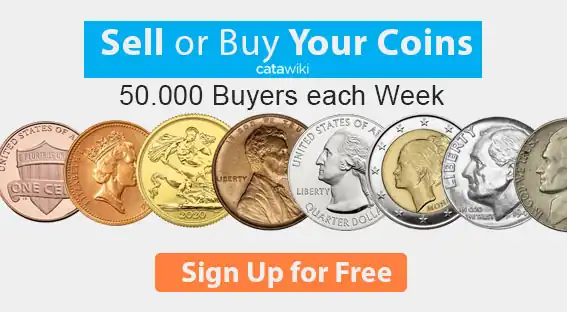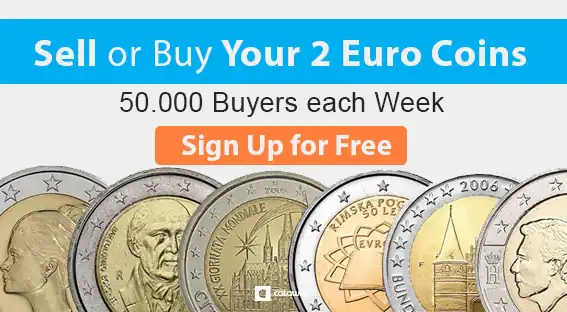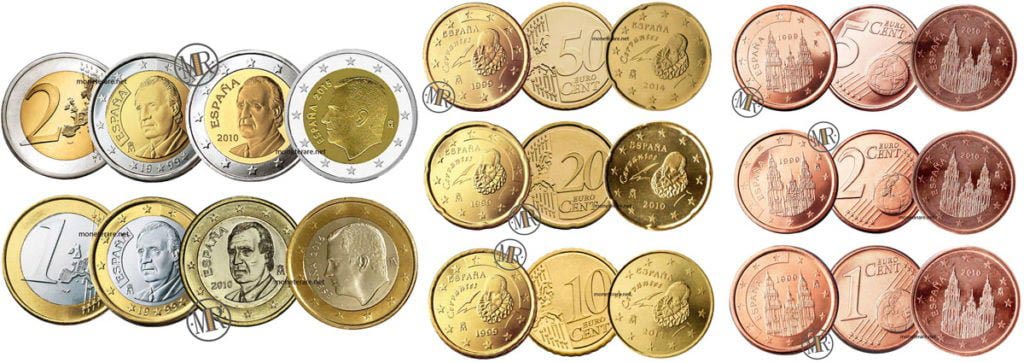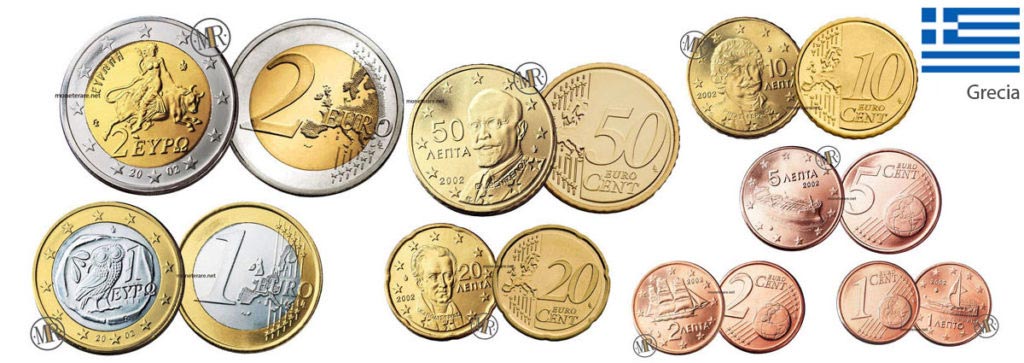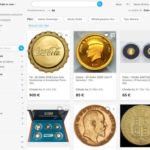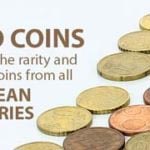If you are looking for information about a particular Lithuania Euro Coins you are in the right place. On this page you will find all the Lithuanian euro coins with the latest prices and rarities of the 1 euro coins of Lithuania, 2 euro coins of Lithuania and all cents.
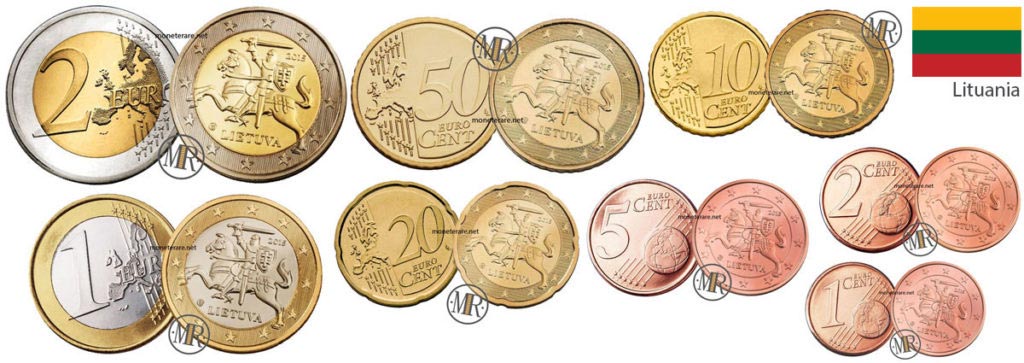
Introduction
Slightly behind the other countries of the European Union, Lithuania too, in the end, has switched to the single European currency: the Euro.
Before that, there were several currencies that followed one another. Before 1922, the Ostmark, a currency issued by the German occupying forces during the First World War, was commonly used in Lithuania.
From October 2, 1922, however, was introduced the Litas with the value of 10 litas = 1 U.S. dollar and divided into 100 Centas. Over the years, the litas has always been a strong currency and in 1938 the following exchange rate was reached: 1 dollar = 5.9 litas.
In April 1941, however, with the annexation of Lithuania to the Soviet Union, the Litas was completely replaced by the Soviet Ruble. The exchange rate was equivalent to 1 litas = 0.9 rubles.
Second introduction of the Litas
In 1993, however, there was a second introduction of Litas. Even before this year, an introduction of the Litas was being considered, which would “accompany” the Ruble even if Lithuania did not become independent and remained under the control of the Soviet Union.
Already in 1989, in fact, several artists were asked to present drafts for the new coins and people began to think about which historical figures to use for the facades of the various coins.
On 1 March 1990 the Bank of Lithuania was founded and ten days later the State declared its independence.
As mentioned, on June 25, 1993, the Litas was officially introduced, which had an exchange rate equivalent to 1 US dollar = 4.5 litas, which was reduced to 4.2 litas within a couple of weeks.
The Euro Era
From February 2, 2002, however, the litas was pegged to the Euro with an exchange ratio of 3.45280 litas = 1 Eur. Although Lithuania became a de facto member of the Eurozone, the Litas and the Euro continued to coexist.
On June 4, 2004, however, it was announced that from January 1, 2015 the Euro would replace the litas.
The Lithuanian litas is officially out of date from January 15, 2015.
After this necessary introduction concerning the history of numismatics in Lithuania and the introduction of the Euro, our journey begins to discover the different coins that characterize this State.
We will see together the technical characteristics and the of each single currency in Euro of Lithuania.
1 Cent Lithuania Euro Coins
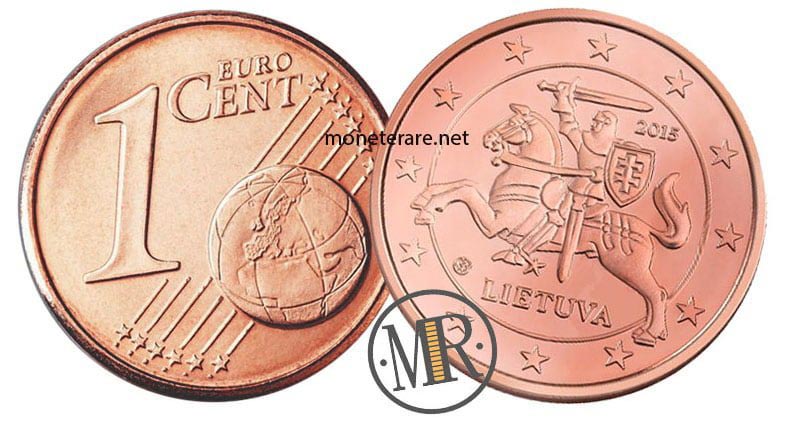
The first coin that we are going to analyse is, of course, the Lithuanian 1-cent coin. This was made by Antanas Zukauskas.
On the obverse side, the coin depicts the knight Vytis, a historic national hero, symbol of the Baltic state and also featured on the Lithuanian national coat of arms. Above, next to the sword, there is the thousandth of minting while below the symbol of the Mint of Vilnius LMK.
On the side is the inscription LIETUVA, which means LITHUANIA. The whole is surrounded by 12 five-pointed stars representing the countries of the European Union.
On the reverse side, the coin has the same face as the other European 1-cent coins with the representation of Europe.
But let’s move on to the technical specifications:
Technical specifications of the Lithuanian 1-cent Euro Coin
- Materials : The material used is copper-plated steel in which 94.35% of steel is present and 5.65% of copper.
- Thickness: The thickness is 1.67 mm.
- Weight: Weight is equal to 2.30 g
- Diameter: The diameter is 16.25 mm
- Outline: The contour is completely smooth
- Engraver: Antanas Zukauskas
Value and Circulation of 1 cent Lithuania Euro Coins
2 Cents Lithuania Euro Coins

Let us now move on to the next denomination, the 2 cents euro coin of Lithuania. Also in this case the author is Antanas Zukauskas.
The white knight Vytis is depicted in the centre of the coin. The latter is the symbol of the Baltic state and is also present in the national coat of arms of Lithuania.
Above right is indicated the thousandth of minting while below the inscription LIETUVA which means precisely LITHUANIA. On the left side, the symbol of the Vilnius Mint, LMK, is indicated.
All this is surrounded by the 12 five-pointed stars that represent the States of the European Union.
On the reverse side, the coin shows the same representation of Europe as on all the 2-cent coins of the European states.
Let’s see now the technical characteristics.
Technical specifications of the Lithuanian 2-cent Euro Coin
- Materials: The material used is also in this case steel plated with copper in which steel is present for 94.35% and copper for 5.65%.
- Thickness: The thickness is 18.75 mm
- Weight: Slightly heavier than the previous coin, 3.06 g
- Diameter: The diameter is 18.75 mm
- Outline: The contour is characterized by the horizontal thread in incuso
- Engraver: Antanas Zukauskas
Value and Circulation of 2 cents Lithuania Euro Coins
5 Cents Lithuania Euro Coins
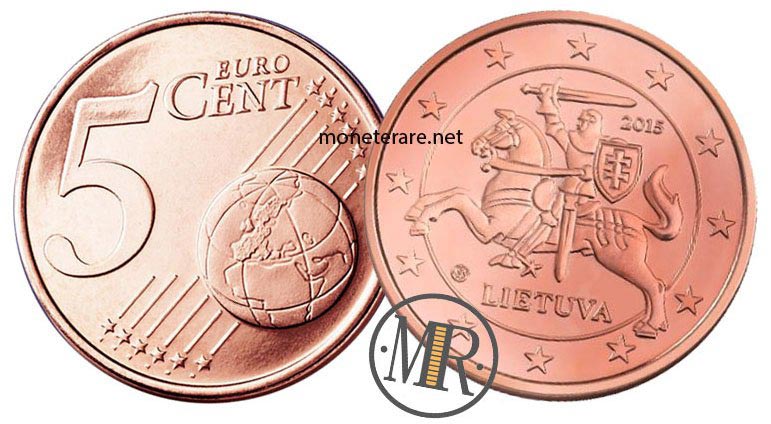
We now come to the 5-cent Lithuanian Euro coin. We always talk about the same author also for this coin or Antanas Zukauskas.
On the obverse side, the coin depicts the knight Vytis on his horse with the shield contracted and the sword facing up. On the right, just next to the sword, is engraved the thousandth of minting while in the lower part of the coin, exactly under the horse, there is the inscription LIETUVA which means LITHUANIA.
Instead, on the left there is the symbol of the State Mint LMK (Lietuvos Monety Kalykla). On the edge of the whole coin are represented the 12 five-pointed stars symbol of the States of the European Union.
On the reverse side, the coin has the same face as the other 5-cent European coins with the representation of Europe in the world.
Let’s get right to the technical specifications:
Technical specifications of the Lithuanian 5-cent Euro Coin
- Materials: The material also in this case is steel plated with copper (steel 94.35% – copper 5.64%)
- Thickness: The thickness is always 1.67 mm
- Weight: Weight increases slightly to 3.92 g
- Diameter: The diameter is 21.25 mm.
- Outline: The contour is completely smooth
- Engraver: Antanas Zukauskas
Value and Circulation of 5 cents Lithuania Euro Coins
10 Cents Lithuania Euro Coins
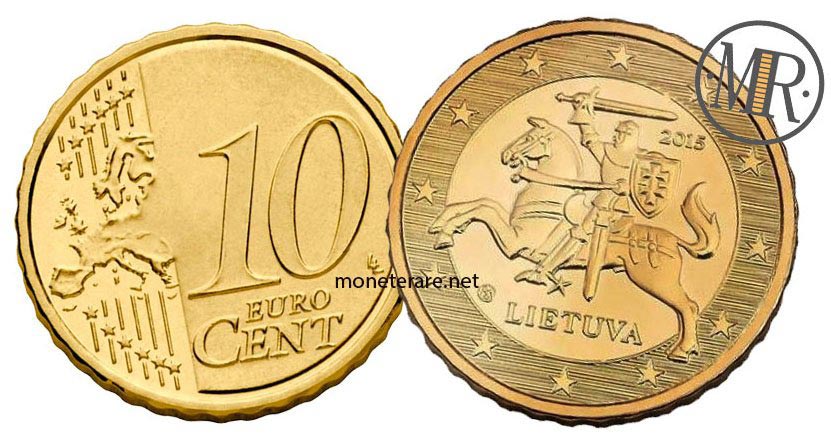
We’ve come to the 10-cent coin from Lithuania. Again, the author is Antanas Zukauskas.
On the obverse the coin depicts the knight Vytis in the middle, riding his horse with his sword drawn. This is the symbol of the Baltic state and is also present on the national coat of arms of Lithuania.
To the right near the sword there is the thousandth of minting while in the lower part of the coin there is the symbol of Mint LMK and the inscription LIETUVA which means LITHUANIA.
The outline is characterized by the 12 five-pointed stars representing the states of the European Union.
On the reverse side, the coin has the same face as the other 10-cent coins of the European States with the representation of Europe itself. Unlike many other countries, it has a single series.
Let’s see now the technical characteristics:
Technical specifications of the Lithuanian 10-cent Euro Coin
- Materials: The material used is Nordic Gold, 89% of which is copper, 5% aluminium, 5% zinc and 1% tin.
- Thickness: The thickness is slightly higher than the coins seen so far reaching 1.93 mm.
- Weight: Weight also increases significantly to 4.10 g
- Diameter: The diameter is equal to 19.75 mm
- Outline: The contour is grooved with thick knurling
- Engraver: Antanas Zukauskas
Value and Circulation of 10 cents Lithuania Euro Coins
20 Cents Lithuania Euro Coins
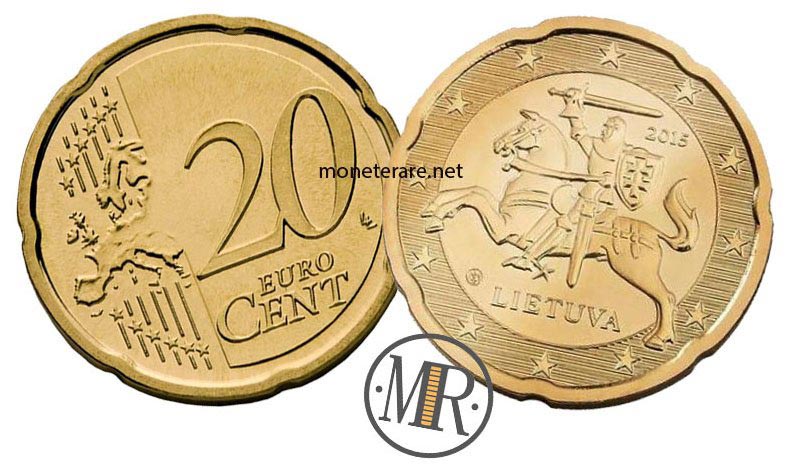
We come to the 20-cent coin of Lithuania. Also in this case, as far as the author is concerned, we speak of Antanas Zukauskas.
The coin depicts the knight Vytis, the symbol of the Baltic state, on the Obverse and also on the Lithuanian national coat of arms. Immediately on the right, next to the sword, there is the thousandth of minting.
Under the knight’s horse there is the inscription LIETUVA which means LITHUANIA and on the left the symbol of Vilnius Mint “LMK”.
The whole is surrounded by 12 five-pointed stars representing the countries of the European Union.
On the reverse side, the coin has the same face as all other 20-cent European coins with the representation of Europe in the world.
But let’s see the technical characteristics together:
Technical specifications of the Lithuanian 20-cent Euro Coin
- Materials: Like the 10-cent coin, the 20-cent Euro coin is made of Nordic Gold made of 89% copper, 5% aluminium, 5% zinc and 1% tin.
- Thickness: The thickness is 2.14 mm
- Weight: Weight increases even further to 5.74 g
- Diameter: The diameter is equal to 22.25 mm
- Outline: The contour is characterized by a wide knurling
- Engraver: Antanas Zukauskas.
Value and Circulation of 20 cents Lithuania Euro Coins
50 Cents Lithuania Euro Coins

We immediately move on to the 50 euro cents of Lithuania. This coin was made specifically by Antanas Zukauskas.
In the Obverse there is the representation of the heroic knight Vytis riding his white horse and with the sword facing upwards. Immediately below the steed the coin shows the inscription LIETUVA which means LITHUANIA and the symbol of the Mint “LMK”.
On the right instead, immediately next to the sword, is indicated the thousandth of minting. The whole is surrounded by the 12 five-pointed stars that represent the States of the European Union.
As far as the reverse is concerned, it is identical to the other European 50 cent coins with the representation and the positioning of the European Union in the world.
Let’s see the technical peculiarities:
Technical specifications of the Lithuanian 50-cent Euro Coin
- Materials: The 50 centesimi coin of Lithuania is made of Nordic Gold, an alloy composed of 89% copper, 5% zinc and aluminum and 1% tin.
- Thickness: The thickness is 2.38 mm.
- Weight: The decidedly important weight is equal to 7.80 g
- Diameter: The diameter is equal to 24.25 mm
- Outline: The contour is grooved with thick knurling
- Engraver: Antanas Zukauskas
Value and Circulation of 50 cents Lithuania Euro Coins
1 Euro Coin of Lithuania
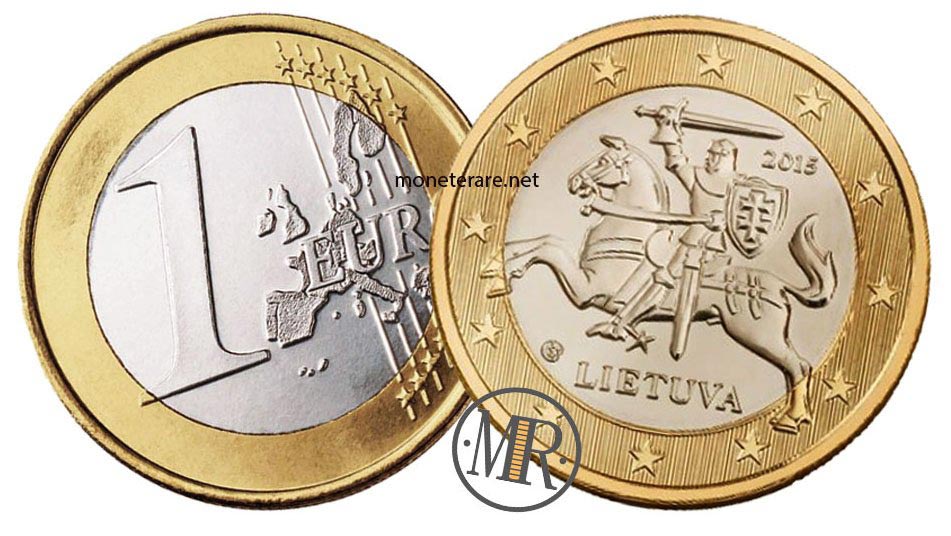
Now we come to the 1 euro coin of Lithuania also made by the same author, Antanas Zukauskas.
The coin has a double section. On the inside of the coin, on the obverse, there is the knight Vytis, national hero of Lithuania, symbol of the Baltic countries and also present on the Lithuanian national coat of arms.
Instead, on his right, next to the unsheathed sword, there is the thousandth of minting while under the horse is engraved with the words LIETUVA which means LITHUANIA. On the left of this writing there is instead the Mint symbol “LMK”.
In the outermost part of the coin there are the 12 five-pointed stars representing the States of the European Union.
On the reverse side, the coin has the same face as the other 1 euro coins of the European countries.
Let us turn instead to the technical characteristics:
Technical specifications of the Lithuanian 1 Euro Coin
- Materials: The material is different depending on the section. The outer one is made of nickel – brass (copper 75% – zinc 20% – nickel 5%), the inner one is made of copper-nickel (copper 75% – nickel 25%).
- Thickness: The thickness is 2.33 mm.
- Weight: weight slightly decreases compared to the previous coin to 7.50 g
- Diameter: Same for the diameter up to 23.25 mm
- Outline: The contour is striped discontinuously
- Engraver: Antanas Zukauskas
Value and Circulation of Lithuanian 1 Euro Coins
2 Euro Coin of Lithuania
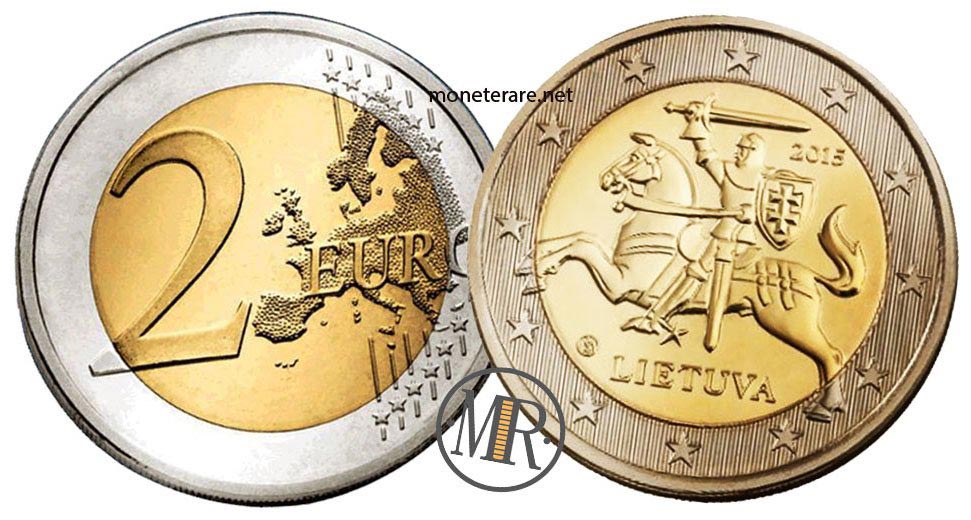
Finally, here we are with Lithuania’s last euro coin, the 2 euro coin. Also in this case the author is Antanas Zukauskas. If you want to check each of the many 2 Euro Commemorative Coins of Lietuva you can check this page: Lithuania 2 Euro Coins.
This coin, like the 1 Euro coin, has a double section: external and internal. Starting from the Obverse we see that the representation is that present on all other coins in Lithuanian Euro that is the knight Vytis national symbol of Lithuania and the Baltic States.
Under the steed there is the inscription LIETUVA which means LITHUANIA while immediately on the left there is the Mint symbol “LMK”.
To the right of the sword is the thousandth of a coinage.
In the outermost part of the coin are represented instead the 12 five-pointed stars which indicate the states of the European Union.
As far as the Reverse this is concerned, like all other European 2 Euro coins, it presents the representation of Europe.
Let’s see the technical characteristics together:
Technical specifications of the Lithuanian 2 Euro Coin
- Materials: Also in this case we speak of a double material depending on the section. The external one is nickel – brass (copper 75% – zinc 20% – nickel 5%), the internal one is made of copper-nickel (copper 75% – nickel 25%).
- Thickness: The thickness is reduced to 2.20 mm.
- Weight: Weight on the contrary increases to 8.50 g
- Diameter: The diameter is 25.75 mm
- Outline: The contour is finely galvanized with the words “LAISVÉ, VENYBÈ, GEROVÈ” or “Freedom, Unity, Prosperity”.
- Engraver: Antanas Zukauskas.
Value and Circulation of Lithuanian 2 Euro Coins
Would you like to see more Euro coins?
- Two pages you can’t miss: 2 Euro Commemorative Coins and Rare Euro Coins
- The precious Vatican euro coins can be seen here and also the San Marino euro coins
- Here you can see the Malta euro coins and here the Cyprus euro coins.
- Euro coins from Germany can be found here and Euro coins from Estonia and Latvia Euro Coins here.
- Euro coins from France can be found here, as well as Euro coins from Austria.
- Also of great interest are the euro coins from Greece and the euro coins of Luxembourg.
- Here you will find Lithuania Euro coins and Andorra Euro coins
- We also talked about Slovenian Euro coins and Slovakia Euro coins.
- Check also Spanish Euro Coins here and Euro Coins of Portugal here.
- The Netherlands euro coins can be found here and the Ireland euro coins here.
- All precious Monaco Euro coins are here and Belgium Euro coins here
